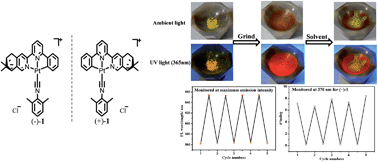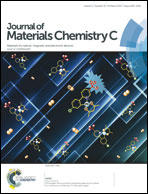Mechano-induced luminescent and chiroptical switching in chiral cyclometalated platinum(ii) complexes†
Abstract
A couple of enantiomeric chiral cyclometalated platinum(II) complexes [Pt((−)-L1)(Dmpi)]Cl ((−)-1) and [Pt((+)-L1) (Dmpi)]Cl ((+)-1) [(−)-L1 = (−)-4,5-pinene-6′-phenyl-2,2′-bipyridine, (+)-L1 = (+)-4,5-pinene-6′-phenyl-2,2′-bipyridine, Dmpi = 2,6-dimethylphenylisocyanide] were synthesized. Two polymorphs (Form-Y and Form-R) of the complex (−)-1 were obtained. The crystallographic studies of both forms revealed that the emission and electronic circular dichroism (ECD) spectra of these complexes at solid state were sensitive to the intermolecular effects and to the molecular surrounding environments. The yellow forms (Form-Y) of the complexes (−)-1 and (+)-1 were found to undergo crystal-to-amorphous transformation upon mechanical grinding, resulting in luminescent and chiroptical switching behaviours as evidenced by emission and ECD spectra. The mechanochromic process can be reversed repeatedly by the addition of a few drops of dichloromethane. When the counteranion Cl− in 1 was replaced with trifluoromethanesulfonate (OTf−), complexes [Pt((−)-L1)(Dmpi)]OTf ((−)-2) and [Pt((+)-L1)(Dmpi)]OTf ((+)-2) were obtained. Complexes (−)-2 and (+)-2 showed a more pronounced luminescent switching behaviour, suggesting that the switching properties can be tuned by the counteranions.


 Please wait while we load your content...
Please wait while we load your content...